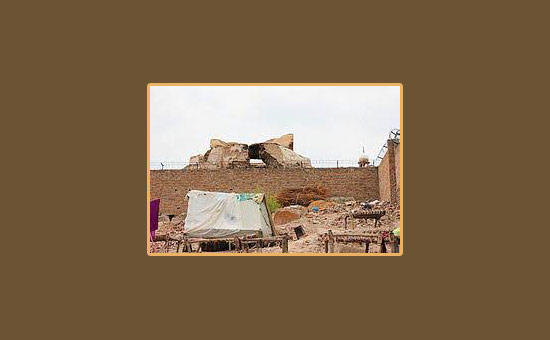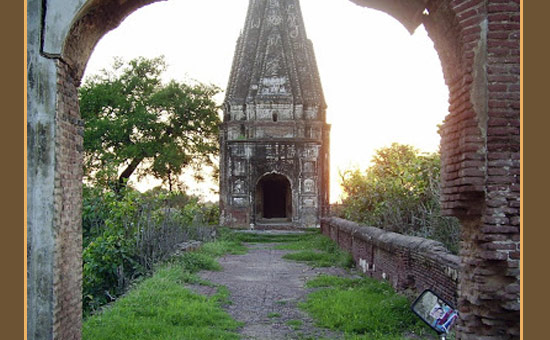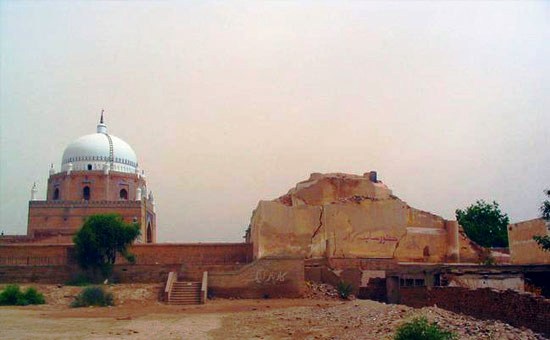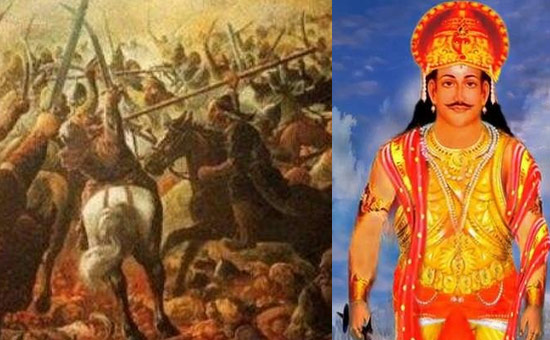- Article tells about 3 cities in modern day Pakistan that were important to Hindus, how they came under Muslim rule and their destruction thereafter.
- The invading
Muslims were defeated in Battle of Bahraich 1033.
- The next
invasion was by Mohammed Ghori in 1187.
Part one was about the brutal Muslim
conquest of Sindh, Multan, Afghanistan and how they used deceit to
unsusceptible Hindus to conquer them. Here is part two.
Today
cities like Kandahar, Kabul, Makran and regions of Balouchistan, Sindh, West
Punjab etc. which are considered to be a part of the Islamic West, were wholly
Hindu majority parts of Bharatvarsha right up to the16th century.
“The Shahi Ruler Veka/ Vakkadeva ruled the northern region of Afghanistan, had established a Shiva Mandir there and issued copper coins of the Elephant and Lion type with the legend Shri Vakkadeva”. Source- ‘Mazare Sharif Inscription’.
Like other
parts of the world Bharatvarsha too suffered destruction of their cities, temples
and culture by Islamic invaders. Even today there is evidence of the long
forgotten Hindu past, in the form of ruins of Hindu Shrines and structures and
some surviving ancient Hindu temples.
Some of
the ancient cities of historical importance to Hindus are Peshawar, Multan and
Lahore. Read on.
Peshawar (Purushapur)
From Sanskrit Purushapur/ पुरूषपुर the town was renamed Peshawar by Akbar. In Persian Peshawar means meaning ‘frontier town’.
The
ancient Purushpur was the western terminus of a Mauryan road that connected the
city to its capital Patliputra, near the modern day Patna. Peshawar was also headquarters of the Nath Panthi Yogis.
The Sufis, Hydaris of the invading Muslims were influenced by Nath Yogis and adopted
their yogic practices.
Peshawar had its first encounter with Muslims when the Hindu Shahis fought the invading forces in 986 CE. On November 28, 1001, Sabuktigin's son Mahmud Ghazni established the Ghaznavid Empire in Peshawar region.
 Prahladpuri
Temple, Multan.
Prahladpuri
Temple, Multan.
Lahore (Luvkushpura)
Luvkushpura or Lavapuri as Lahore was earlier called is said to be founded by Sri Ram’s son, Lava. To this day the Lahore Fort has an empty ‘Temple of Lava’ called Loha, hence name is Lohawar/ Fort of Loha. The arches and
patterns on walls of the temple suggest that there were other structures or that
the temple was much bigger.
After a long siege and battle in which Trilochanapala Shahi was killed, Lahore was annexed by Mahmud Ghazni in 1021. Thereafter the city was torched and depopulated.
 Lava Temple in the Lahore
Fort.
Lava Temple in the Lahore
Fort.
Multan (Kashyap Puri)
Kashyap Puri/ Mulasthana is derived from the Sanskrit word ‘Mul’ meaning the root. It was one of the biggest and most prominent city of the Indian sub-continent.
The town
was called Parhalad Puri after Hiranyakashyap’s son Prahlad succeeded the throne.
It came to be called Multan because of the Malavas/ Mallians/ Malloi tribe in that region, around the time of Alexander’s invasion around 326 BCE. The Malavas later migrated southwards to present-day Rajasthan and ultimately to Madhya Pradesh and Gujarat. Their coins dated between 250 BCE and 250 CE bear ‘Malavanam jaya’ meaning victory of the Malavas.
Mulasthana
was known for Adityasthana/ Aditya Mandir. This temple and other sun temples in Martand in Kashmir, Modhera in Gujarat and Konarak in Orissa made a Tetralogy of famous Sun Temples across Bharatvarsha. Adityasthana is said to have been built by Shri Krishna’s son Samba.
Muhammad
bin Qasim captured the city but chose not to destroy the Temple because of the
large offerings made by Hindus. Apart from the Moorthi of Adityanath being
the principal source of revenue to the Arab state, it was also used by them for
defence. Whenever any Hindu Raja attacked to reconquer Multan, the Arabs would
exhibit the revered Moorti on the fort wall and threatened to break it.
“When Muhammad bin Qasim was told about the revenue the temple generates, he spared the idol of Multan, but he hung a piece of cow’s flesh on its neck by way of mockery”. Source History of Sind, Vol.2, Dr Mumtaz Husain Pathan, published 1978 in Pakistan.
Muhammad bin Qasim looted & carried on ships to Basra, 330 chests of treasure containing 13,300 mounds of gold from the Adityasthana….The idol of Multan which was named after Adith (sun) was built in the Karta-Jug Trerta Yuga”. Quote Sanskrit scholar AL-Beruni.
 Multan's Hindu temple (right), by Joan Lendering
Multan's Hindu temple (right), by Joan Lendering
When the Arabs failed to conquer Bharatvarsha,
the Turks and Mongols/ Mughals took up their so called holy war against
Bharat.
The
second Muslim crusade towards Bharatvarsha was not led by Arab Muslims but by
the newly converted Persian, Turkish and Mongols. The first Turko-Persian
chieftain to attack the Hindu domains was Sabuktagin.
When the Saffarid rule weakened and Sistan/Seistan
(border region of eastern Iran and south western Afghanistan) became a
part of Samanid Empire, the Hindu Shahis seeing the danger, stepped up on their
western frontier establishing their power at Ghazni.
By mid tenth century, Turkish slaves began to acquire power in the Samanid realm. Alaptigin, a door keeper, defeated the royal army, took over Bamia and Ghazni from the Hindu rulers after a prolonged siege of four months. His son Alaptigin’s son Abu Ishaq succeeded him in 963 A.D.
The Hindu Shahi Raja Jaypala, sensing the serious
threat of the rising Turkish power, attacked Ghazni with a huge army, ousted
Abu Ishaq back to Bukhara and secured their western frontiers. The final defeat
of the last of the Shahi Bheempal in 1026, opened the heartland of Bharatvarsha
to the Muslim invaders. To read
more about it
In contrast with the conversion of Persia, Syria,
Egypt, North Africa, and Spain to Islam in less than 80 years, 635 C.E. - 711,
the Muslims were able to temporarily make a dent into Bharatvarsha only after
more than seven hundred years of consistent aggression and treachery.
The Hindus inflicted the biggest and decisive defeat
on Muslims at the battle of Baharaich in 1033.
Mahumd Ghazni’s son, Masud Ghazni invaded India with an army of more than 100,000 men in May 1031 AD.
After
defeating Anandpal Shahi, whose Kingdom stretched from Kabul to Kashmir,
Sirhind to Multan and Peshawar, and Rai Arjun of Sialkot, Masud advanced
towards Malwa and Gujarat. King Mahipal Tomar tried to check their advance but
was defeated.
Masud penetrated deep in to the Ganges valley and established his camp
at Bahraich (near Lucknow) in eastern Uttar Pradesh. He sent a word to the
surrounding Hindu kings to surrender and embrace Islam.
According to their practice the Hindu kings sent a messenger to Masud that
this land being theirs Masud should peacefully vacate it. To which Masud
replied that all land belonged to Allah, he could settle wherever he pleased.
He added that it was his holy duty to convert to Islam all those who did not
recognize his Khuda.
On June 13 1033 an allied army of about 120,000 soldiers consisting of seventeen Kings of North of Bharatvarsha under Raja Sukhdev descended on Masud's Ghazni camp at Bahraich near Chittaura Jheel, 8 km away from modern Bahraich on Bahraich-Gond Road. The biggest confederation that ever existed, was of Rai Raib, Rai Saib, Rai Arjun, Rai Bheekhan, Rai Kanak, Rai Kalyan, Rai Makaru, Rai Savaru, Rai Aran, Rai Birbal, Rai Jaypal, Rai Shreepal, Rai Harpal, Rai Hakru, Rai Prabhu, Rai Deo Narayan and Rai Narsinha. Raja Bhoj of Malwa also supported actively.
Showing no mercy, every man in Masood's camp was killed. The Hindus had learnt their lesson about Muslim treachery of over four hundred years starting 638 A.D. On 14th June 1033 A.D. Salar Masud was beheaded by Raja
Sukhdev.
Thus, Hindus inflicted the biggest and decisive defeat on Muslims at the battle of Bahraich in 1033.
Near Bahraich is the grave of the commander of the invader, ‘Ghazi Mian Masud’. Local Muslims hail him as a Ghazi and a Peer and an Urs is held every year. However, the gallantry
of the Hindu soldiers who lost their lives in this major victory is forgotten.
Sadly some local Hindus visit his grave too.
The victory was so resounding that no Muslim king from the Northwest dared to invade India from 1033 to 1187 A.D.
 Battle of Bahraich. Raja Sukdev (or Suhel Dev) who led the army and beheaded Salar Masud.
Battle of Bahraich. Raja Sukdev (or Suhel Dev) who led the army and beheaded Salar Masud.
The next Muslim onslaught
started in 1187 under the leadership of Mohammed Ghori.
The
Ghaznivid occupiers of the Shahiya kingdom in West Punjab made peace with its
Hindu neighbours. They issued coins in Sanskrit using the Sanskrit version of
Muslim names e.g., Mahamada for Mohammed. The Hindus assumed that the
Ghaznivids, would like the Greeks, Huns, Kushans merge into Hindu society
adopting Sanatana Dharma and its culture.
After
defeating the Shahiyas, the Ghaznavids forcibly converted the Gauris, cowherd
Hindu subjects of Hindu Shahiyas, 980 C.E.
Two
hundred years later ie by 1187 these converts had
become cruel and merciless. There was not a trace of their Hindu
ancestry except the name Gauri, derived from Gau/ cow. It is from their name
comes the Islamized name of the place Ghaur/ Ghor.
The Muslim chieftain of Ghor, Muhammad Ghauri/ Mohammed-ibn-Sam/ Mu'izz al-Din, a Hindu convert overthrew the Muslim ruler of Ghazni. Annihilating the kingdom of their former tormentors, the Ghaznavids, ironically now became the new ruthless tormentors of their ancestors, the Hindus.
After overcoming the Ghaznivid governor of Punjab,
Mohammed Ghori in 1187, marched way into India only to find it blocked by three
powerful Hindu kingdoms, the Solankis/ Chalukyas of Anahilwada in Gujarat, the
Chahmanas/ Chouhans of Delhi, Ajmer and Sambhar and the Rathods/ Gahadwals of
Kannauj, Uttar Pradesh.
Mohammed
allied himself with the Muslim governor of Sindh and with full fury of
aggression attacked Gujarat. The Solankis and Chalukyas defeated him at the
battle on the plains below Mount Arbuda / Abu, forcing him to flee across the
Thar Desert.
Having tasted defeat, Mohammed decided to make
use of subterfuge. Like Sabuktgin, he studied Hindu warfare.
Invading from another route, Mohammed advanced through West Punjab and attacked the fortress of Bhatinda in East Punjab which was the frontier of the domains of Prithiviraj Chauhan, the brave Maharaja of Sambhar/ Shaka-ambara.
In Part 3 read, how the Rajputs defeated the Arab Muslims for 500 years and the counter aggression that saved Hindu society fro extinction.
Also read
1 The
Battle of Bahraich
2 Natha
Pantha